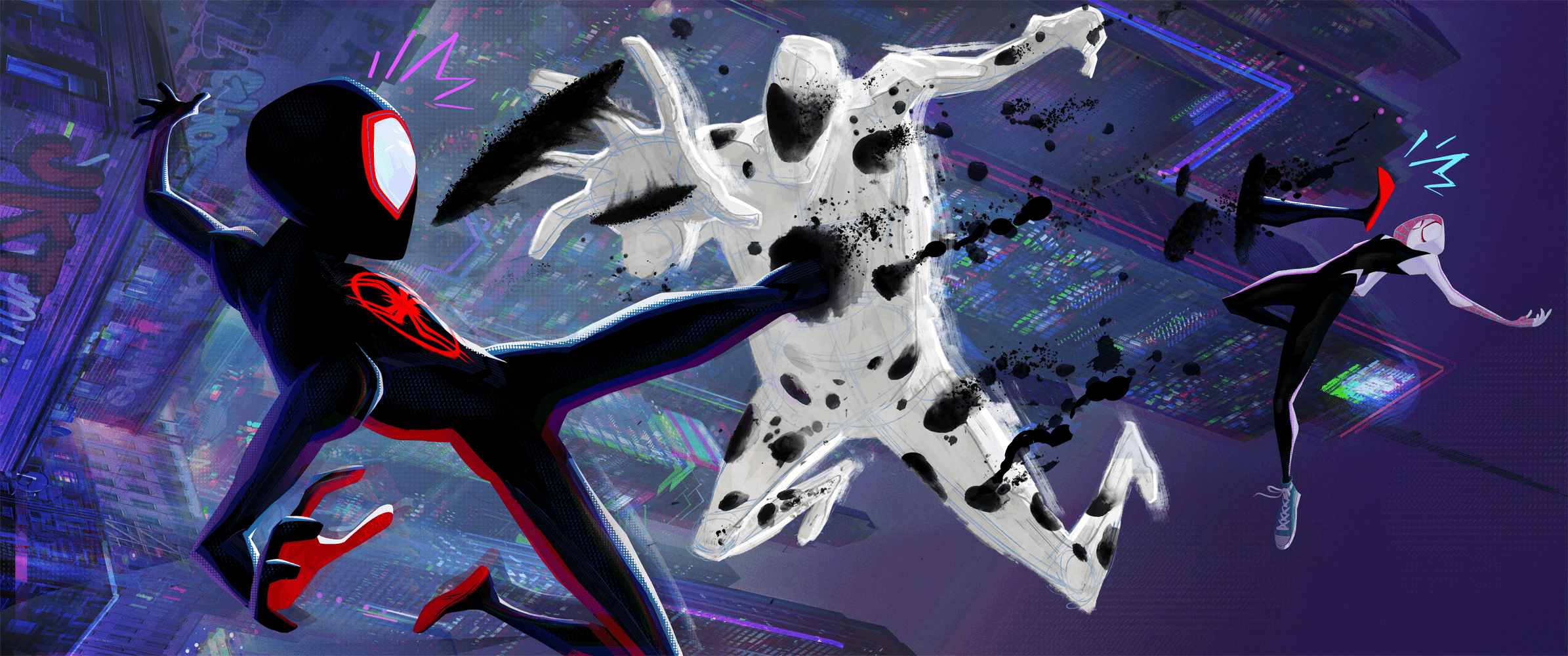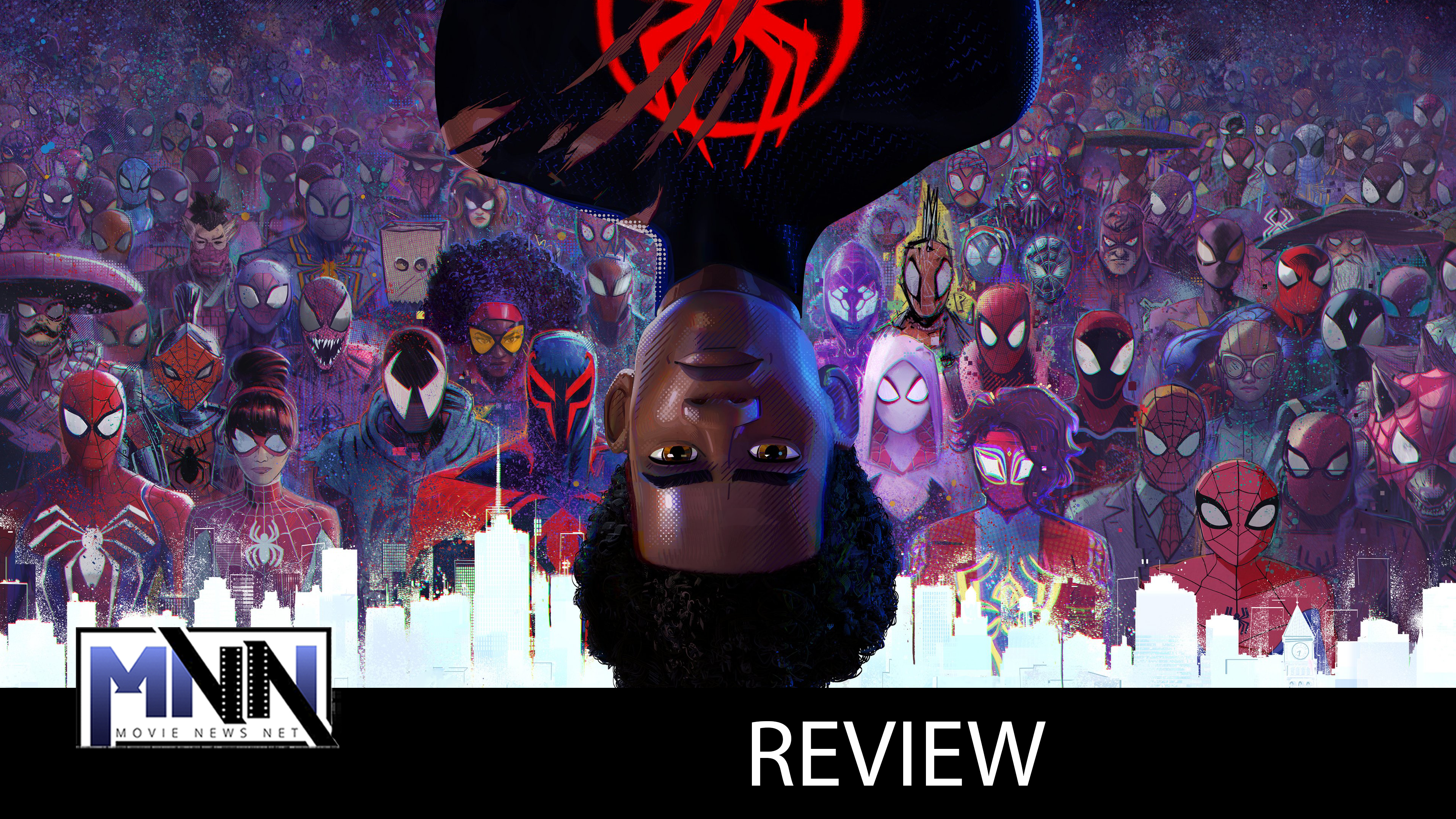‘Spider-Man: Across the Spider-Verse’ Review: A Film That Swings for the Fences and Delivers on Almost Every Level
The career of Phil Lord and Chris Miller can be pretty much defined by one motto: “Defying expectations”. It’s not only that they were able to flip the script on highly-criticized ideas like a LEGO movie or a 21 Jump Street big-screen reboot, but that they were able to pull all of them off by focusing on story and characters and letting the pieces fall into the right places by going from there. Their 2018-produced Spider-Man: Into the Spider-Verse (which Lord co-wrote and they both spearheaded from its inception all the way into the film’s release) raised a lot of eyebrows at first (an animated, non-Peter Parker Spider-Man film sandwiched between three live-action appearances in Avengers: Infinity War, Avengers: Endgame, and Spider-Man: Far From Home? And what is that animation style?), but it ended up warming the hearts of everyone who saw it, including the Academy. Once we knew what they could do, the bar was immediately raised for its follow-up, Spider-Man: Across the Spider-Verse. And once again, they were able to live up to that motto.
As an audience, we realize this is immediately the case after watching an extensive cold open which not only sets the bar for everything that came before but also acted as its own short film inside the larger scope of the story that is about to unfold. Upon first viewing, this cold open struck me as the best part of the entire film, even if what came after it fought very hard to live up to it. It follows Hailee Steinfeld’s Gwen Stacy going through her personal trauma as Spider-Woman and how that’s affected her entire life, from losing her best friend Peter Parker (as was referenced in the first film) to her recruitment by Miguel O’Hara (Oscar Isaac) and Jessica Drew (Issa Rae).

Gwen Stacy in Columbia Pictures and Sony Pictures Animation’s SPIDER-MAN: ACROSS THE SPIDER-VERSE. Photo By: Courtesy of Sony Pictures
Of all the impressive accomplishments that Spider-Man: Across the Spider-Verse was able to pull off, one of the biggest one is, no doubt, the way it balanced its characters. There is no shortage of faces in the film, and if you were concerned that they might not be able to handle all of them properly, rest assured, each one got their moment to shine, and we never prioritize secondary characters over our protagonists. Directors Joaquim Dos Santos, Kemp Powers, and Justin K. Thompson deliver here a masterclass of building momentum, and Gwen Stacy’s cold open works as a microcosm of what the entire movie is — we start off with a heartfelt connection between our main character and his family/friends, realize how being a Spider-hero has affected their daily life, all of it keeping a consistent rhythm that never stops and never looks back, and in fact builds toward a climactic third-act that involves multiversal characters and reveals, all of it ending in a cliffhanger that both needs resolution to feel fully satisfying but also works because the character arcs have been completed.
The structure of the story feels very natural as well, which almost sounds like a miracle for the superhero genre these days. We meet back with Miles (Shameik Moore) after the opening credits, finding him as a stand-in for Harry Potter at the beginning of The Chamber of Secrets. He is having a hard time keeping up with his family and his condition as Spider-Man (or a wizard, in Harry’s case), but most of all, he misses the friends he made last year. He draws them in his notebook and thinks about them all the time. Why won’t they come to visit him? Why don’t they contact him? Did they forget about young Miles? While all of that is happening, he meets his new nemesis, the Spot (Jason Schwartzman), who has plenty of hole-filled jokes which, unlike in Ant-Man and the Wasp: Quantumania, do work. The Spot works very well as a villain (though the film kind of puts him aside past its halfway point), and by far the best moment for the character was the reveal of who he actually is. Strap in.

Miles Morales (Shameik Moore) and Gwen Stacy (Hailee Steinfeld) take on The Spot (Jason Schwartzman)
in Columbia Pictures and Sony Pictures Animation’s SPIDER-MAN™: ACROSS THE SPIDER-VERSE. Photo By: Sony Pictures Animation
There is plenty to love in Spider-Man: Across the Spider-Verse, a movie that has as many references and visual nods to all different iterations of Spider-Man across all possible mediums as it has heart and a sense of authenticity. This is not a replay of any other movie. It builds upon the entire history of the character, on- and off-screen, and uses it to its advantage, to tell a very personal story to Miles, and also Gwen. Across the Spider-Verse is what happens when we put creatives in charge who, not only have a deep reverence, respect, understanding, and love for the character they are handling, but also know what they are doing and have something to say about the character, about the genre, about life, about fate, about humanity, about hate, about love, and everything in between. There’s stuff to love here for everyone, because Lord and Miller, who co-wrote the script with Dave Callaham, prioritized story over everything else. It’s one of the few blockbuster films in a long time that doesn’t have a chopped and convoluted edit, which might be surprising because of the sheer amount of characters it involves.
That being said, though, I have complicated feelings on a variety of issues, which might or might not be cleared up after my second viewing (which will happen sooner rather than later). The first 30-40 minutes of the film include two or three action sequences that go on for too long, and the overall pace of the film would have benefitted from trimming them down. The film, which clocks in at 2h20min, feels very heavy, especially as the entire multiverse begins to unfold upon Miles between the second and third acts. There is a lot of movie in Across the Spider-Verse, and it is vital for audiences not to feel exhausted by the time they get to the heavy part. To do that, the filmmakers could have cut some of the fluff from the battles against Vulture and Spot in the beginning, and also tighten up the second act a bit more; a 2h05min runtime would have just nailed it.

Spider-Man/Miles Morales (Shameik Moore) in Columbia Pictures and Sony Pictures Animations’ SPIDER-MAN™: ACROSS THE SPIDER-VERSE. Photo By: Sony Pictures Animation
In that transition from acts two to three, there is a big story reveal, and it is something that all characters Miles comes across in the film up until that point have been trying to keep from him. We realize this while watching the film and so does Miles, but from the moment we notice that something’s up to the moment we are told exactly what it is, there is a good chunk of the film where the story takes a backseat and the plot kicks in. The filmmakers suddenly ask for a bit of patience while they introduce new characters and plot elements that will later be necessary for everything to make sense, but they do so at the expense of Miles, and the audience as a result, being left behind. It motivates us to keep watching the film, for sure, but on my first viewing it seemed like the directors were asking too much from the audience, and to compensate for that, they awarded us with a very cool action sequence where two new Spider-People are introduced.
Spider-Man: Across the Spider-Verse ends on a massive cliffhanger. It is the product of an extremely well-realized reveal during the last five minutes of the film, but there is no way around it — this is Part One of two, and they are not even shy about it, because the last frame of the film is followed up by a “To Be Continued”. Of course, we know the story here — the studio initially commissioned one sequel, but when coming up with the story for it, the filmmakers realized it would work better as a two-parter. (Spider-Man: Beyond the Spider-Verse swings into theaters on March 29, 2024.) The difference between this film and the usual first of two parts is that the story of the characters, namely Gwen and Miles, feels complete. Their arcs have a beginning, a middle, and an end. But the plot is left hanging, and that did not work very well for me upon first viewing — even Avengers: Infinity War felt like a complete film where the bad guy happened to win the day. We know that there is a sequel coming and that it will eventually be seen as the first of two movies, but the truth is that both the characters’ arcs in the film, as well as its plot, are wrapped up by the time the credits roll. This is not entirely the case here.

Spider-Man (Shamiek Moore) in Columbia Pictures and Sony Pictures Animation’s SPIDER-MAN: ACROSS
THE SPIDER-VERSE. Photo By: Sony Pictures Animation
These issues are what kept me from joining the ranks of pretty much everyone on the Internet calling this movie a masterpiece and the best film of all time. It’s not. It’s endlessly enjoyable and rewatchable, and I am certain I will get over most of the small issues I have with the film after watching it a few more times. It is definitely the best superhero film since Spider-Man: No Way Home, and possibly going back further. It feels almost impossible to appreciate the movie in its entirety, which is why I’ve been holding the review for two days since watching it. I wanted to see it a second time to give it the time it deserved, but since I couldn’t manage to do so, I went ahead with it. The more I think about it, the higher I put it among other Spider-Man films and even the entire genre. It took me a few watches to appreciate No Way Home in its entirety, and I can feel it will be the same here.
If you still haven’t been swayed by the entire Internet raving about it, I highly recommend you go see it. Spider-Man: Across the Spider-Verse is currently playing in theaters worldwide.
Miguel Fernández is a Spanish student that has movies as his second passion in life. His favorite movie of all time is The Lord of the Rings, but he is also a huge Star Wars fan. However, fantasy movies are not his only cup of tea, as authors like Scorsese, Fincher, Kubrick or Hitchcock have been an obsession for him since he started to understand the language of filmmaking. He is that guy who will watch a black and white movie, just because it is in black and white.







